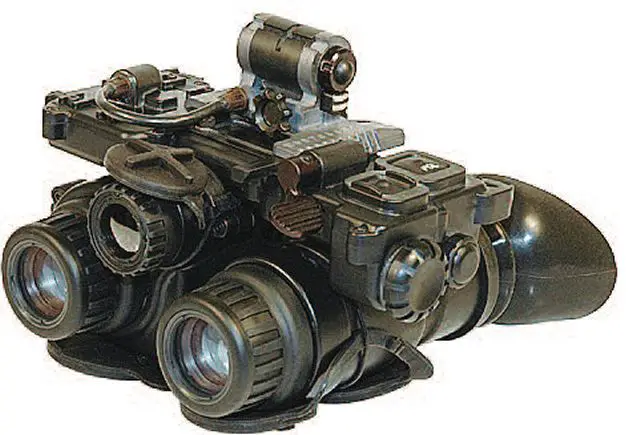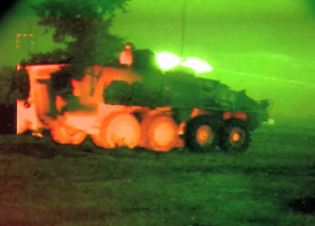The AN/PSQ-36 is a binocular night vision Goggle designed and manufactured by the American Company L3. The FGS (Fusion Goggle System) combines the light amplification capability of Image Intensification (I2) devices such as AN/PVS-15 night vision goggles with the heat sensing capability of thermal imaging systems. The Fusion Goggle System (FGS) (AN/PSQ-36) is a portable, battery operated system that allows for detection, observation, and target identification under adverse conditions including light rain, smoke, light snow, and low light to total darkness.
|
| Design |
|
The AN/PSQ-36 FGS allows the operator to adjust the viewed image from 100% I2 to 100% thermal, or a varying mix of the two. The system amplifies available light and thermal signatures and fuses them together to produce a clear image under adverse conditions. The FGS provides unparalleled image resolution in situations where active infrared (IR) illumination is not an option.
|
| Power source |
|
The AN/PSQ-36 FGS is about the size of a standard binocular style night vision goggle system. It attaches to standard dovetail interface helmet mounts and is powered by a remote battery back mounted on the rear of the helmet. The FGS runs off four 3V CR123A batteries with over 8.5 hours of battery life operation. . All functions are operated by simple control buttons and knobs. Interpupilary distance is adjusted via standard ANVIS-style controls.
|
| Technology |
| The AN/PSQ-36 FGS provides better increased situation awareness capability due to the improved threat detection of the fusion technology. It allows the operator to see through more battlefield obscurants than any other device. On their own, standard L3 Gen3 OMNI VIII Auto-Gated I² tubes produce high quality images with superb resolution, providing excellent recognition capability. The FGS fuses these two technologies, providing the operator with all the benefits of I², while producing a thermal overlay. The fused image has three modes: thermal overlay, thermal outline, and full thermal. The Overlay produces an otherwise standard I² image with orange thermal heat signatures over anything that is producing heat. This mode is extremely well-adapted to identifying threats quickly through obscurants. The outline mode produces a thin orange thermal outline around anything that is giving off heat. The rest of the image is standard I². This mode is especially useful when using an IR laser pointer because the operator can identify threats while still having recognition capability and can engage them with the laser. |
| Features |
|
• Compact, lightweight, ergonomic design
• Compatible with all standard issue near IR aiming lights
• Designed to work with weapon-mounted aiming and laser systems
• Target identification in light rain, smoke, snow, low light and total darkness
• Can be used handheld or helmet mounted
• Interoperable with ANVIS or BNVIS helmet mounts
• Battery pack provides extended operation
|
| |
| Specifications |
| Back to top |
|
Magnification
|
|
1x
a
|
|
Field of view
|
|
- I2 FOV = 38°
- LWIR 21° H x 16°V
|
|
Focus range
|
|
25cm to infinity
|
|
Weight
|
|
580 gr
|
|
Producer
|
|
L3
|
|
|
Thermal
|
|
SelectableWhite Hot, Black Hot, Gutline Modes, User adjustable I2 gain and Thermal brightness
|
|
Oprerating Temperatures
|
|
-32°C to 49°C (-25°F to 12D°F)
a
|
|
Dimensions
|
|
3.9"L x 3.1 ”H x 6.1 ”W
|
|
Power Source
|
|
Four 3-volt lithium CR123 batteries
|
|
Country Producer
|
| United States |
|
|
| |
|






























